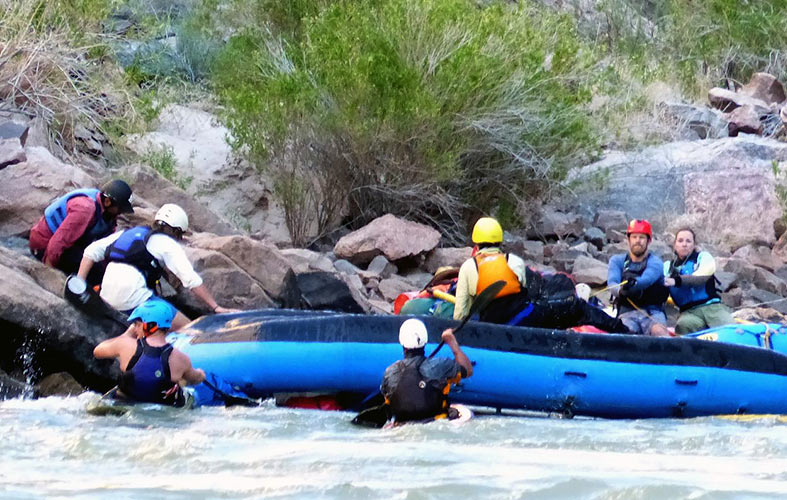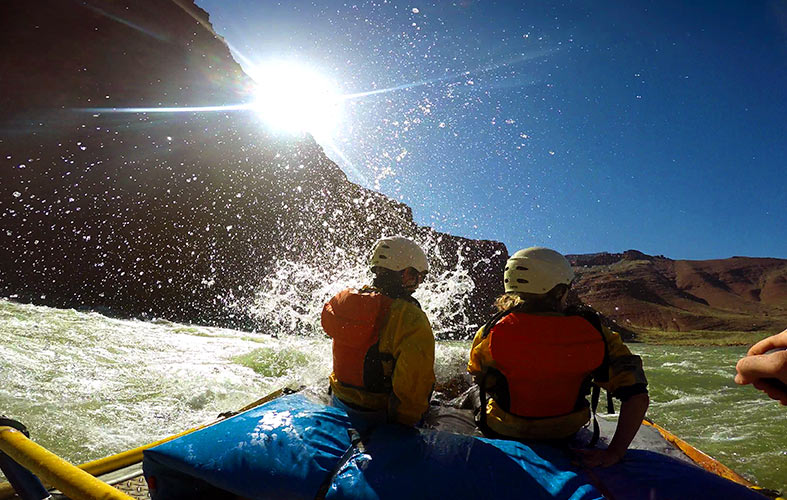Scouting Hance
Before we arrive at Hance, the guides get out of the boats and climb up some rocks to scout it out. They strategize about the best way to approach it, and which guides should go first and last. Then with serious faces, everyone straps on their helmets. Even veteran guide Larry Guenther, who is usually smiling and singing loudly any manner of songs, is quiet and focused. Jordy gives one last pep talk about what to do if we flip, and we head toward the rapid.
In the quiet before the roar, as each boat takes its turn slipping down the rapid’s tongue, there is a soldierly comradery that comes over the guides. They raise their arms with a clenched fist to each other, or nod and say almost somberly, “Have a good ride, man.”
The rest of us just hold on and bear down.
We bump, we jostle, we hoot, we holler, we get wet and then … Whew! Done. That’s the worst of it. Fun even. We can pretty much relax now.
Except we can’t.
The flip at 85-Mile Rapid
On the second to last rapid of the trip, on the second to last day, on a rapid that is not even named in some guidebooks — 85-Mile Rapid, rated a 3 on the canyon’s 10-point scale — our boat gets caught in a nasty snarl of waves that rocks us harshly back and forth until … “So this is happening,” I think … we flip.
I see it all go by in slow motion: I’m up, tipping to the side, and then “splash!”
I can tell as I’m going over that the boat is about to flip right on top of me. Sure enough, when I pop up, it’s dark and I’m under the raft. Luckily, I’m so aware of this, it’s only for a second. I quickly surface on the other side and hold on to the raft’s rope handle. I have just enough time to think, “Whoa, we actually flipped! And I’m OK!” before I remember to look for my boat mates.
Apparently, graduate student Trevor Waldien was tossed fully from the boat and rode the rapid fairly easily on his own until hitting calmer waters and swimming to shore. I look around and see graduate student Roxanne Banker in the water near me, looking surprised and about to get hit by an oar. She dodges it and grabs the boat with me.
Before we both know it, guide Devon Lambert paddles up in a kayak and tells us to grab on to its back handle. We kick as he paddles us to shore, where guide and UC Davis physics Ph.D. candidate Dan Hernandez takes our hands and leads us to another boat.
We wait there while our raft is brought to shore, and about a dozen people take 15 minutes to flip it and its contents over. By the grace of good knots and dry sacks, very little is waterlogged.
As for me, I feel strangely exhilarated. The thing I most feared on this trip happened, and I was just fine.

The team works together to right a flipped boat. Credit: Evan Wolf /UC Davis
Between flips
Later that night — our last of the trip — guide and forest ecology doctoral student Zack Steel asks me if I thought the flip made my experience here better or worse.
“Definitely better,” I say. Not that I want to do it again.
“That’s usually how the passengers in the boat feel,” he says. “But it’s never what the guide who flips them feels.”
I make sure to thank my guide for bringing a little excitement to my trip and helping me face this particular fear. He still feels bad. He’d never flipped his boat before. But there’s a saying among guides: You’re always between flips. If you haven’t had one yet, just wait, you will.
Graduate student Millie Levin tells the story of how a wave knocked her boat mates, UC Davis multimedia specialist Joe Proudman and guide Dan Hernandez, out of their raft. Credit Joe Proudman/UC Davis
"Places like this bring out people’s best selves."








